Match column-I with column-II and select the correct option from the codes given below.
| Column-I | Column-II |
|---|---|
| A. Stele | I. Innermost layer of cortex |
| B. Endodermis | II. Suberin |
| C. Casparian strips | III. All the tissues exterior to vascular cambium |
| D. Bark | IV. All the tissues inner to endodermis |
A IV, B I, C II, D III
A III, B II, C I, D IV
A I, B II, C III, D IV
A IV, B II, C I, D III
Correct Answer :
A. A IV, B I, C II, D III
A - Stele: It is the central core of the stem and root of a vascular plant, consisting of the vascular tissue (xylem and phloem) and associated supporting tissue.
B - Endodermis: It is an inner layer of cells in the cortex of a root and of some stems, surrounding a vascular bundle.
C - Casparian strips: It is a band of cell wall material deposited on the radial and transverse walls of the endodermis, and is chemically different from the rest of the cell wall - the cell wall being made of lignin and without suberin - whereas the Casparian strip is made of suberin and sometimes lignin.
D - Bark: Bark is the outermost layers of stems and roots of woody plants. Plants with bark include trees, woody vines, and shrubs.
Related Questions
Which of the following process helps the trichomes in preventing water loss?
Where companion cells helps in maintaining the pressure gradient in the sieve tubes.
Where plants absorb water through the roots and then give off water vapor through pores in their leaves.
Where activity of cork cambium builds pressure on the remaining layers peripheral to phellogen and ultimately these layers dies and slough off.
None of the above
Match the followings and choose the correct option
| Column-I | Column-II |
|---|---|
| A. Cuticle | I. Guard cells |
| B. Bulliform cells | II. Outer layer |
| C. Stomata | III. Waxy layer |
| D. Epidermis | IV. Empty colourless cell |
A III, B IV, C I, D II
A I, B II, C III, D IV
A III, B II, C IV, D I
A III, B II, C I, D IV
The given figure shows T.S. of monocot stem. Identify the correct labelling of A to F marked in the given figure.
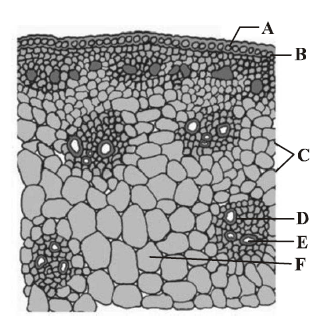
A Epidermis, B Hypodermis, C Vascular bundles, D Phloem, E Xylem, F Ground tissue
A Cuticle, B Epidermis, C Sclerenchymatous sheath, D Sclerenchymatous hypodermis, E Parenchymatous sheath, F Phloem
A Cuticle, B Epidermis, C Sclerenchymatous hypodermis, D Sclerenchymatous sheath, E Parenchymatous sheath, F Phloem
A Cuticle, B Epidermis, C Sclerenchymatous hypodermis, D Sclerenchymatous sheath, E Parenchymatous sheath, F Protoxylem
Which of the following statements is correct?
Lenticels occur in most woody trees.
Sclerenchymatous cells are usually present in cortex.
The vascular tissue system is divided into three main zones- cortex, pericycle and pith.
The conjoint vascular bundles usually have the xylem located only on the outer side of the phloem.
Cork is formed from
phellogen
vascular cambium
phloem
xylem
The given figure shows the secondary growth in a dicot stem. Their parts are marked as A, B, C, D, E & F. Choose the correct labelling of the parts marked as A to F.

A Phellem, B Phellogen, C Medullary rays, D Secondary xylem, E Secondary phloem, F Cambium ring
A Phellem, B Phellogen, C Medullary rays, D Secondary phloem, E Secondary xylem, F Cambium ring
A Phellogen, B Phellem, C Medullary rays, D Secondary xylem, E Secondary phloem, F Cambium ring
A Phellem, B Phellogen, C Cambium ring, D Secondary xylem, E Secondary phloem, F Medullary rays
Some vascular bundles are described as open because these
are surrounded by pericycle but not endodermis.
are capable of producing secondary xylem and phloem.
possess conjunctive tissue between xylem and phloem.
are not surrounded by pericycle.
Tissue(s) present in an annual ring is/are
secondary xylem and phloem.
primary xylem and phloem.
secondary xylem only.
primary phloem and secondary xylem.
Match the elements of xylem given in column I with their character given in the column II and choose the correct option.
| Column-I | Column-II |
|---|---|
| A. Xylem vessels | I. Store food materials |
| B. Xylem tracheids | II. Obliterated lumen |
| C. Xylem fibres | III. Perforated plates |
| D. Xylem parenchyma | IV. Chisel-like ends |
A IV; B III; C II; D I
A III; B II; C I; D IV
A II; B I; C IV; D III
A III; B IV; C II; D I
Match column-I with column-II and choose the correct option.
| Column -I | Column -II |
|---|---|
| A. Bulliform cells | I. Initiation of lateral roots |
| B. Pericycle | II. Root |
| C. Endarch xylem | III. Grasses |
| D. Exarch xylem | IV. Dicot leaf |
| E. Bundle sheath cells | V. Stem |
A III, B V, C IV, D I, E II
A II, B V, C I, D III, E IV
A II, B IV, C I, D III, E V
A III, B I, C V, D II, E IV
The given figure shows apical meristem of root apex with few part marked as A, B and C. Identify the correct labelling of A, B and C.
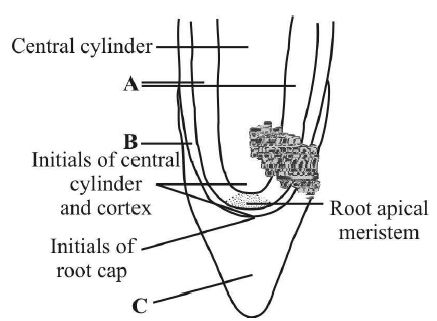
A Vascular structure, B Protoderm, C Root cap
A Cortex, B Endodermis, C Root cap
A Cortex, B Protoderm, C Root cap
A Tunica, B Protoderm, C Root cap
Read the following statements and answer the question.
- It has a sclerenchymatous hypodermis, a large number of scattered vascular bundles and a large parenchymatous ground tissue.
- Vascular bundles are conjoint and closed.
- Peripheral vascular bundles are generally smaller than the centrally located ones.
- Phloem parenchyma is absent, and water- containing cavities are present within the vascular bundles.
Which plant anatomy is being described by the above statements?
Dicotyledonous root
Monocotyledonous root
Dicotyledonous stem
Monocotyledonous stem
T.S. of monocot leaf is given below, certain parts have been marked by alphabets (A G). Which one is the option showing there correct labelling?
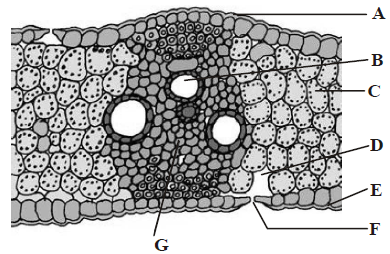
A Adaxial epidermis, B Xylem, C Mesophyll, D Sub-stomatal cavity, E Abaxial epidermis, F Stoma, G Phloem
A Adaxial epidermis, B Abaxial epidermis, C Xylem, D Sub-stomatal cavity, E Stoma, F Mesophyll, G Phloem
A Adaxial epidermis, B Phloem, C Mesophyll, D Sub-stomatal cavity, E Abaxial epidermis, F Xylem, G Stoma
A Adaxial epidermis, B Xylem, C Stoma, D Substomatal cavity, E Abaxial epidermis, F Phloem, G Mesophyll
Match column-I with column-II and choose the correct option.
| A. Spring wood or | I. Lighter in colour early wood |
|---|---|
| B. Autumn wood or | II. High density late wood |
| .. | III. Low density |
| .. | IV. Darker in colour |
| .. | V. Larger number of xylem elements |
| .. | VI. Vessels with wider cavity |
| .. | VII. Lesser number of xylem elements |
| .. | VIII. Vessels with small cavity |
Which of the following combination is correct ?
A II, IV, VII, VIII; B I, III, V, VI
A I, II, VII, VIII; B III, IV, V, VI
A I, III, V, VI; B II, IV, VII, VIII
A I, III, VII, VIII; B II, IV, V, VI
Which of the following figure is a type of permanent tissue having many different types of cell?
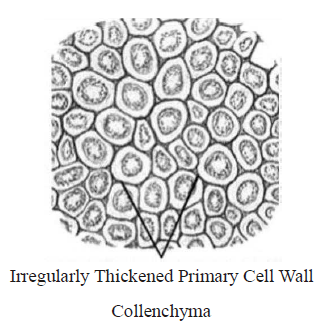
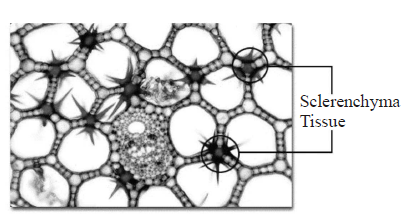
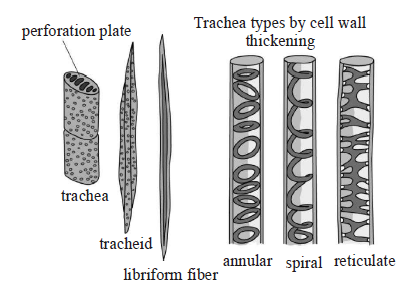
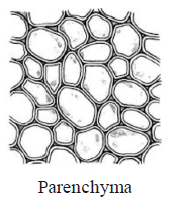
Identify A, B and C in the given figure of shoot apical meristem
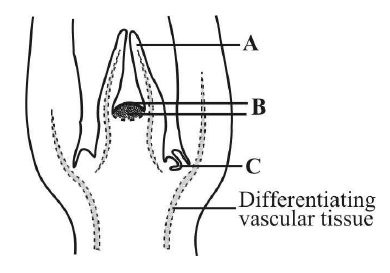
A Leaf primordium, B Shoot apical meristem, C Axillary bud
A Leaf primordium, B Shoot apical meristem, C Apical bud
A Root hair primordium, B Root apical meristem, C Axillary bud
A Root hair primordium, B Root apical meristem, C Terminal bud
Match the names of the structures given in column-I with the functions given in column-II, choose the answer which gives the correct combination of the two columns :
| Column-I | Column-II |
|---|---|
| (Structure) | (Function) |
| A. Stomata | I. Protection of stem |
| B. Bark | II. Plant movement |
| C. Cambium | III. Secondary growth |
| D. Cuticle | IV. Transpiration |
| V. Prevent the loss of water | ... |
A V, B III, C I, D IV
A I, B IV, C V, D III
A II, B IV, C I, D III
A IV, B I, C III, D V
Match the terms given in column I with their funciton given in column II and choose the correct option.
| Column-I | Column-II |
|---|---|
| (Term) | (Functions) |
| A. Meristem | I. Photosynthesis, storage |
| B. Parenchyma | II. Mechanical support |
| C. Collenchyma | III. Actively dividing cells |
| D. Sclerenchyma | IV. Stomata |
| E. Epidermal tissue | V. Sclereids |
A I, B III, C V, D II, E IV
A III, B I, C II, D V, E IV
A II, B IV, C V, D I, E III
A V, B IV, C III, D II, E I
T.S. of dicot leaf passing through the midrib is given below. Certain parts have been marked by alphabets (A to H). Choose the option showing their correct labelling.

A Epidermis, B Spongy mesophyll, C Palisade mesophyll, D Stomata, E Guard cells, F Phloem, G Metaxylem, H Protoxylem
A Epidermis, B Palisade mesophyll, C Spongy mesophyll, D Sub-stomatal cavity, E Stoma, F Phloem, G Xylem, H Bundle sheath
A Epidermis, B Palisade mesophyll, C Spongy mesophyll, D Stomata, E Guard cells, F Epidermis, G Xylem, H Phloem
A Epidermis, C Palisade mesophyll, C Spongy mesophyll, D Stomata, E Guard cells, F Phloem, G Metaxylem, H Protoxylem
Trees at sea do not have annual rings because
soil is sandy.
there is climatic variation.
there is no marked climatic variation.
there is enough moisture in the atmosphere.
The length of different internodes in a culm of sugarcane is variable because of
size of leaf lamina at the node below each internode
intercalary meristem
shoot apical meristem
position of axillary buds
As secondary growth proceeds, in a dicot stem, the thickness of
sapwood increases.
heartwood increase.
both sapwood and heartwood increases.
both sapwood and heartwood remains the same.
Which meristem helps in increasing girth?
Lateral meristem
Intercalary meristem
Primary meristem
Apical meristem
Match column-I with column-II and select the correct option from the codes given below.
| Column-I | Column-II |
|---|---|
| A. Stele | I. Innermost layer of cortex |
| B. Endodermis | II. Suberin |
| C. Casparian strips | III. All the tissues exterior to vascular cambium |
| D. Bark | IV. All the tissues inner to endodermis |
A IV, B I, C II, D III
A III, B II, C I, D IV
A I, B II, C III, D IV
A IV, B II, C I, D III
Phellogen and phellem respectively denote
cork and cork cambium,
cork cambium and cork,
secondary cortex and cork,
cork and secondary cortex,
Which of the following is responsible for the formation of an embryonic shoot called axillary bud?
Lateral meristem
Apical meristem
Intercalary meristem
Both
A tissue is a group of cells which are
similar in origin, but dissimilar in form and function.
dissimilar in origin, form and function.
dissimilar in origin, but similar in form and function.
similar in origin, form and function.
Bast fibres are made up of _____________cells.
sclerenchymatous
chlorenchymatous
parenchymatous
aerenchymatous
T.S. of dicot stem is given below, certain parts have been marked by alphabets (A I). Choose the option which shows their correct labelling.

A Epidermis, B Epidermal hair, C Parenchyma, D Starch sheath, E Hypodermis (collenchyma), F Vascular bundle, G Bundle cap, H Medulla or pith, I Medullary rays
A Epidermal hair, B Epidermis, C Hypodermis (collenchyma), D Parenchyma, E Endoderm is (Starch Sheath), F Pericycle, G Vascular bundle, H Medullary rays, I Medulla or pith
A Epidermal hair, B Epidermis, C Hypodermis (collenchyma), D Starch sheath, E Parenchyma, F Vascular bundle, G Bundle cap, H Medulla or pith, I Medullary rays
A Epidermal hair, B Epidermis, C Parenchyma, D Hypodermis (collenchyma), E Starch sheath, F Vascular bundle, G Bundle cap, H Medulla or pith, I Medullary rays
Which of the following are present in monocot root ?
conjoint, collateral, open polyarch vascular bundle.
exodermis, endarch, tetrarch closed vascular bundles.
suberized exodermis, casparian strip, passage cells, cambium.
suberized exodermis, polyarch xylem, pith.
